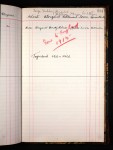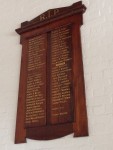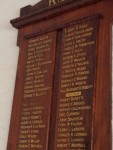ROBERTS, Margaret Dorothy
Margaret Roberts’ life was a remarkable one by any measure. Born in a Welsh workhouse, deemed too delicate for domestic service or hard work, she blossomed in body and mind and trained as a nurse in London. Her nursing career took her twice across the world from England to Australia and back, and then to war as a staff nurse in the Queen Alexandra Imperial Military Nursing Service Reserve.
In late 1917, she sailed on the SS Osmanieh from England to Alexandria. At the entrance to Alexandria Harbour on 31 December 1917, Osmanieh was hit an enemy mine, exploded and sank. Roberts was one of eight nurses and nearly 200 other personnel drowned.
Roberts is commemorated on plaques in York Minister in England and St Asaph’s Cathedral in Wales, and on a roll of honour in St Peter’s Church, Eastern Hill, Melbourne.
***
Before the War
Margaret Dorothy Roberts was born on 30 October 1870, in the Union Workhouse in Dolgellau, Merionethshire in Wales. Her baptismal certificate dated 4 November 1870 identified her mother as Laura Roberts but named no father. Laura was 23 years old and according to the workhouse entry in the 1871 Census of England and Wales, was an ‘imbecile’. She died of consumption when Margaret was around five.
When Margaret was 13 – of an age for employment – the Union Workhouse made contact with the Community of the Sisters of the Church, an Anglican religious order, and asked them to provide her with some training. She worked in the kitchen of the Sisters’ large and expanding Orphanage of Mercy in Kilburn (London) from 1886. (The orphanage had 300 children in 1886 and 500 by 1892 [http://www.childrenshomes.org.uk/KilburnMercy/]). In 1891, 21 year old Margaret began helping in the Sisters' Infirmary and by 1895-96 she was in service as a nurse at a vicarage. Her time there was not entirely successful. ‘She was not strong, and at that time was not very bright, and did not get on’ (Letter from Frances Ashdown [Sister Frances], Hon Sec of the Church Extension Association, 31.3.1925, in Roberts, QAIMNS Service Record, National Archives UK, WO399/7086).
However Margaret’s life and expectations had been transformed at the Sisters’ Orphanage and Infirmary. ‘She developed wonderfully in body and mind while she was with us’, Sister Frances wrote of her years later. Around 1896 she was working and training as a children’s nurse at the workhouse infirmary attached to the parish of St George’s in the East in Middlesex. The former workhouse child was now looking after sick workhouse children.
When Margaret completed her children’s nursing training, she pressed on with more. She studied fever nursing, which covered infectious diseases such as diphtheria, scarlet fever, typhoid and smallpox, any of which could and did still reach epidemic proportions among children and adults in Edwardian England. Then she expanded her training further with general hospital nursing.
By 1900, Margaret was a charge nurse at the South Western Hospital Stockwell. It was a specialist fever hospital in London (http://ezitis.myzen.co.uk/southwestern.html). Erected by the Metropolitan Asylum Board, the hospital’s patients were the sick poor of London. She worked there for around seven years.
By the time she was 35, Margaret had lived in a workhouse and an orphanage, then worked in the orphanage, a workhouse infirmary and a public hospital for the destitute sick. She maintained a close relationship with the Sisters of the Church, which led her on a new venture to Australia.
As a qualified and highly experienced children’s nurse, she was ideal to assist the Sisters of the Church in their ‘Home for Waifs’ known as Parkerville, south of Perth. Sister Kate, the founder, operator and driving force behind Parkerville, had been in England briefly for health reasons in 1907. When she returned to Western Australia, she took with her at least two English trained nurses for Parkerville, one of whom was Margaret Roberts. Sister Kate and the nurses travelled together on the SS Medic reaching Albany, Western Australia on 29 December 1907 (Passenger List, SS Medic; Albany Advertiser, 1.1.1908, p2; Vera Whittington, Sister Kate: A life dedicated to children in need of care, UWA Press, 1999, pp141-42). No doubt they were very welcome: whooping cough had just swept through the children’s home.
Roberts spent eight months at Parkerville in charge of ‘the infants’ department’. For whatever reason – Parkerville’s isolation (30 kilometres by train from Perth), Sister’s Kate’s personality and opportunities for nurses in the new state’s developing medical system are all plausible explanations – in August 1908 Roberts left Parkerville for a government hospital run by WA’s Medical Department.
In July 1909, this highly experienced children’s nurse with English training became one of the first nurses at the newly opened 20 bed Perth Children’s Hospital. Patient demand immediately outstripped facilities which made for challenging working conditions. Perhaps that or homesickness prompted Roberts to return in England. She returned 3rd class on the SS Salamis via Cape Town and reached London in September. A few weeks later she began nursing at the Park Hospital for Children in Lewisham (London), a former fever hospital that had been disinfected and refurbished for its new role as a convalescent home for sick children from London’s Poor Law infirmaries (www.workhouses.org/MAB-Park).
Roberts was a staff nurse at the Park Hospital for over a year. In February 1912 she set out for Australia for the second time, as matron on a ship contracted to bring domestic servants and other immigrants to Victoria. Domestic servants were in high demand in Melbourne so young women were recruited by the Victorian government’s agent in England (one, Mrs McLeod) and despatched in groups of about 40. They were under the supervision of matrons to ensure reasonable conditions, health and discipline. It seems Roberts and her charges (about 30 among 902 assisted passengers) arrived in Melbourne on SS Gothic, on 16 April 1912. Mindful of the public fear of diseases arriving by ship, the Argus noted that a female had died on the voyage of consumption, and that several passengers had arrived with minor illnesses (Argus, 12.4.1912, p8; 17.4.1912, p5). Roberts may well have been the only nurse on the voyage; the matrons were expected to render assistance to passengers who became ill.
Roberts remained in Melbourne, and undoubtedly reconnected with the Sisters of the Church community there. They were active in Melbourne with various enterprises including schools and clothing depots. The Sisters were also associated with St Peter’s Church, Eastern Hill, the well-known Anglo-Catholic parish. Roberts also became a parishioner. It would have been a congenial environment for her, with the Sisters, Anglo-Catholic worship and teaching familiar from her London associations, and parishioners who nurses working in the various hospitals nearby (sufficient to form a branch of the Church of England Guild of St Barnabas). Roberts was a member of the Guild. Initially, she worked near St Peter’s as a night nurse in Miss Garlick’s Private Hospital in Flinders Lane (1912-13).
Roberts resumed her specialist ‘fever’ nursing in May 1913 when she was appointed a sister at the Queen’s Memorial Hospital in Fairfield. The hospital’s administration had just been the subject of a scathing report and was under considerable public pressure to implement improvements in care and conditions. Her expertise should have been invaluable, particularly as the hospital introduced major changes in 1913–14 (see W.K. Anderson, Fever Hospital: a History of Fairfield Infectious Diseases Hospital, 2002).
Encouraged by St Peter’s clergy and its spiritual atmosphere, a number of women parishioners around this time entered religious communities, notably the Sisters of the Church, or became missionaries. (Colin Holden, From Tories at Prayer to Socialists at Mass, St Peter’s Eastern Hill Melbourne 1846-1990, 1996, pp105-06). In 1914, 43 year old Margaret Roberts became the ‘eighth worker sent from the parish to the Mission field during the years 1911–14’ (Ecclesia, May 1914). Her name was mentioned by the Anglican Archbishop in his annual charge to synod. She was appointed matron at the aboriginal mission at Yarrabah near Cairns in Queensland, a controversial establishment with a troubled recent history. Her experience, progress from the south and arrival in Cairns were noted in various regional newspapers (e.g. Townsville Daily Bulletin, 5.5.1914.p6).
Despite the formal parish send-off and anticipation in the press, Margaret Roberts remained at Yarrabah only a few months. The Australian Board of Missions which ran Yarrabah reported that she resigned because of a 'breakdown', possibly referring to the effect of the tropical climate on her health or even malaria (A.B.M. Review Vol. 5, no. 5 (August 1914), p114.)
That conditions specific to Yarrabah - the climate plus the recent turmoil in its administration - were the key factors in her departure is suggested by the fact that Roberts accepted appointment as a nurse on another aboriginal settlement at Taroom in Queensland, 400 kilometres north west of Brisbane (https://heritage-register.ehp.qld.gov.au/placeDetail.html?siteId=25109). Government-run, Taroom was also a volatile place with aboriginal people from various parts of Queensland brought together in a highly regulated institutional environment. The climate was however less taxing than Yarrabah's.
It was from Taroom in July 1915 that Roberts applied to join the Queen Alexandra Imperial Military Nursing Service (Roberts, Service Record, National Archives [UK]). At nearly 45 she would have been deemed too old for service with the Australian Army Nursing Service.
War Service
Roberts was accepted into the QAIMNS Reserve but she was informed that she could not be appointed for duty until she returned to England at her own expense (Roberts, Service Record). Waiting for her call up in England, she reconnected with the Sisters of the Church again and nursed in the Lady Adelaide Home for Boys they ran in Brondesbury, London.
Without a known relative to name as next of kin on her enlistment form, she nominated the order’s Mother Superior as her ‘Nearest Friend’.
Roberts’ first army pay was issued on 21 March 1916. She was initially sent to the Fargo Military Hospital on Salisbury Plain. This large hospital (1200+ beds) served the massive concentration of Australian and New Zealand soldiers who were training on the Plain for trench warfare on the Western Front. It could be a place of severe cold and wet, with ‘archipelagos of mud’. Many of the hospitals’ patients were admitted with pneumonia, bronchitis and other severe respiratory illnesses which sometimes proved fatal, but there were also cases with gunshot wounds, fractures and other illnesses.
In December 1917, Roberts was called up for active service on a ship transporting sick and wounded soldiers from Egypt back to England. She and other medical personnel sailed to Taranto in Italy and boarded the SS Osmanieh. An English Voluntary Aide on board described the voyage on the ill-fated Osmanieh: the impromptu concert before the ship sailed, the change of course because of submarines, the boat drill (‘the nurses only had to attend the first morning’) and the debilitating seasickness that struck most for several days (VAD Dorothy Morfey, http://1914-18invisionzone.com/forums/index.php?showtopic=37135).
On Monday morning 31 December, in smooth sea and in sight of land, Osmanieh hit a mine at the entrance to Alexandria harbour. The previous day the SS Aragon had been torpedoed in the same spot, but all personnel including nurses had been rescued. Morfey described the scene on the Osmanieh:
‘We were all talking gaily when we (sic) crash! & and we were thrown off the seat which collapsed under us. We looked instinctively to the left & saw a cloud of grey smoke & water & flying bits of wreckage. At the same moment we were soaked by the water pouring down over us … the ship took a violent list … before I knew anything more we were in the water, going down in a whirl & tangle … None of the [life] boats got away at all … you see, the [Osmanieh] went altogether in 4 minutes, & I’m told that any self-respecting ship takes at least ¼ - ½ hour. We were awfully lucky to be so close in & also to have as many ships around & a calm sea.’
Unlike the Aragon, not every one on the Osmanieh survived. Few if any on board were wearing life jackets as the ship was so close to the harbour. The ship’s commander, two officers, 21 crew, 167 troops and 8 nurses, including Margaret Roberts, were lost.
The bodies were recovered and buried in the Hadra War Memorial Cemetery in Alexandria. Roberts was buried by the Reverend George F Packer (not E.F as stated in her service record). Packer was a senior chaplain to the forces in Egypt and, like Margaret, Welsh. Administrative confusion over Roberts name meant her grave and other official documents in her service record had to be emended. The inscription read:
STAFF NURSE
M D ROBERTS
QUEEN ALEXANDRA'S IMPERIAL MILITARY NURSING SERVICE
DIED ON 31 DECEMBER 1917 AGE UNKNOWN
After the War
Margaret Roberts died without making a will. She left very few personal effects, hardly surprising given her life as nurse and missionary with the sick and destitute in both England and Australia. What she did have – in three parcels – fetched £12.1.11 at public auction. The proceeds were sent to the Sisters of the Church.
In 1925, an observant member of the order noticed the name of Staff Nurse M D Roberts in a War Office list advertisement inviting ‘applications from persons supposing themselves entitled as next of kin’ to claim the funds, in this case £27.7.1. The Sisters wrote requesting the funds be directed to them, spelling out their care for her, the continued close connection with her and her support for their work. They forwarded their magazine which included her photograph.
It was to no avail: officially Margaret Roberts had no surviving next of kin, and the Sisters’ request was refused.
Margaret Roberts’ death was noted in Australia, as an entry (incorrect as to date) in the St Peter’s Eastern Hill church address book showed. The parish lost nearly 70 men and one woman, Roberts, on war service. Their names were commemorated on a roll of honour which is still housed in the church precinct. Her death was not mentioned in the parish magazine, nor her name included among the parishioners remembered on the anniversary of their death.
Margaret Dorothy Roberts was also commemorated on the QAIMNS memorial in York Minister and on a commemorative plaque in the cathedral at St Asaph commemorating Welsh nurses who died in the Great War.
Margaret Roberts featured in the East Melbourne Historical Society's 2015 exhibition, 'Gone to War as Sister: East Melbourne Nurses in the Great War'. Her panel can be seen at Gone to War as Sister - exhibition panel 14
Sincere thanks to Howard Satchell of the Great War Memorials group in Flintshire, Wales, who had researched Margaret Dorothy Roberts. It has been a pleasure to flesh out her remarkable story and add material relating to her life in Australia. It would have been impossible without his research and article (http://www.flintshirewarmemorials.com).
Thank you to Geoff Whatron for the reference to Roberts' resignation from the ABM Review, and suggestion about the impact of the climate on her health.
Thanks also to St Peter's Church, Eastern Hill, Melbourne, whose records are now available through ancestry.com.au
Thank you to Sister Marguerite Eamon CSC, archivist at the Community of the Sisters of the Church, for corrections to an earlier version regarding Margaret Dorothy Roberts' life in the 1880s and 1890s.
Janet Scarfe
Professional Historians Australia (SA)
Updated 23 October 2021
Can you help?
Can you correct or provide more information about this person?
Or are you able to help with this history project?
- Family stories and records including photos, documents and memorabilia?
- Stories or information in books, newspapers and on-line?
- Memorial plaques in churches and public places?
- War memorial, church, national and state archives?
If so, please Contact the East Melbourne Historical Society.





